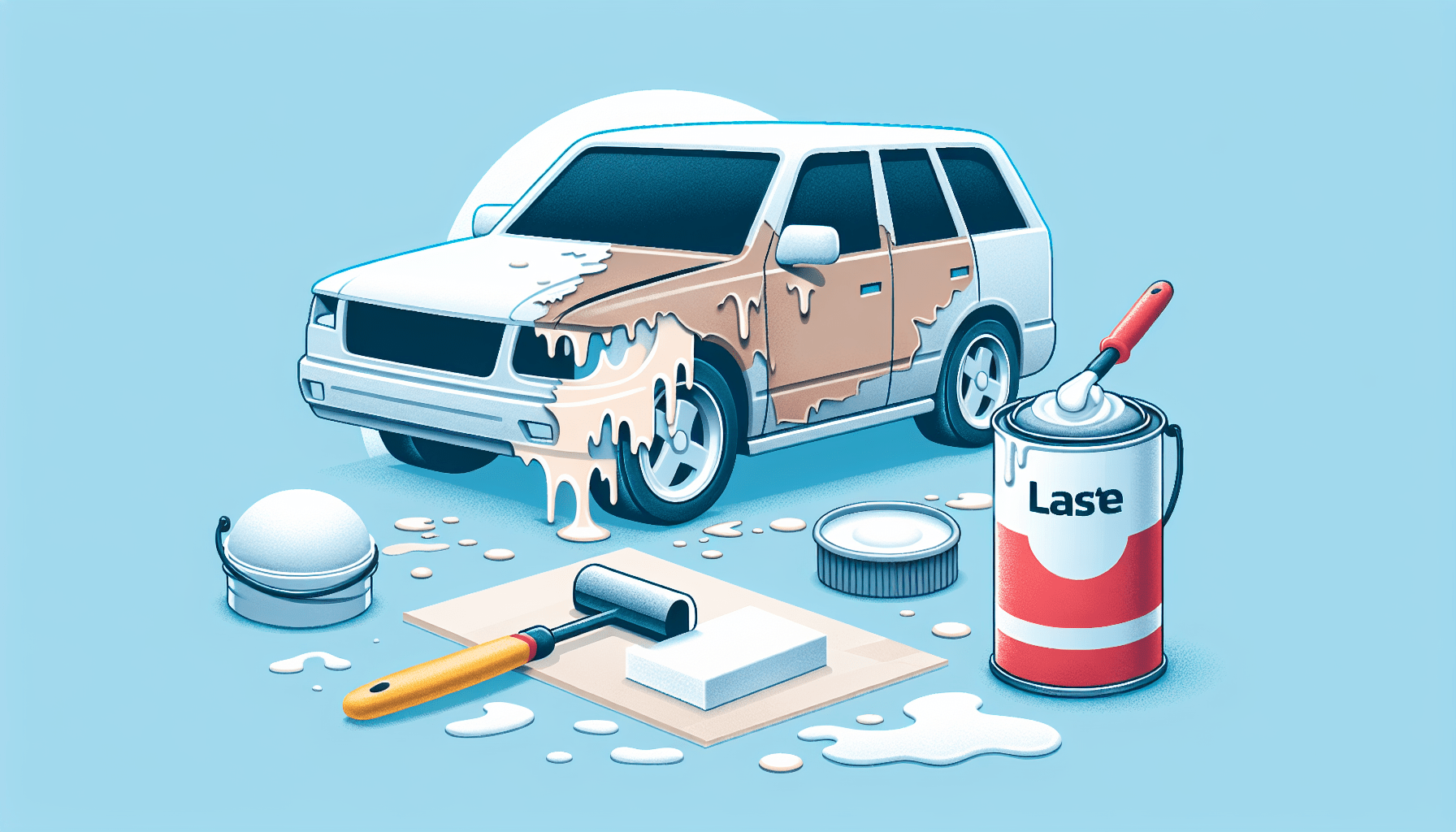If you’ve recently completed a painting project and find yourself with leftover latex paint that you need to dispose of, it’s important to know the proper method of drying it out. In this article, you will learn a simple and effective technique for drying out latex paint, ensuring that it can be safely disposed of and reducing the risk of environmental harm. Discover the step-by-step process that will allow you to dry out leftover latex paint quickly and efficiently, while adhering to responsible disposal practices.

Gather the Necessary Supplies
To properly dry out latex paint, you will need to gather a few necessary supplies. These supplies include:
Materials needed
- Latex paint
- Absorbent materials (such as newspaper or paper towels)
- Scraping tool (such as a putty knife or paint scraper)
- Disposable container
- Paint hardener or cat litter
- Stirring stick or paint stirrer
- Freezer-safe container
- Label for container
- Protective equipment (such as gloves and goggles)
Safety precautions
Before you begin the process of drying out latex paint, it is important to take some safety precautions. Make sure to work in a well-ventilated area to avoid inhaling any fumes. It is also recommended to wear protective gloves and goggles to protect your skin and eyes from any potential contact with the paint. Additionally, follow all manufacturer’s instructions for any products used in the drying process to ensure safe handling.
Prepare the Area
Preparing the area properly is essential to prevent any damage or mess during the drying process. Follow these steps to prepare the area:
Choose a well-ventilated location
Select a location for drying out the latex paint that is well-ventilated. A space with open windows or doors is ideal, as it allows for proper air circulation and helps to dissipate any fumes.
Protect the surrounding surfaces
Before you begin working with the paint, ensure that you protect the surrounding surfaces to prevent any accidental spills or splatters. You can do this by using plastic drop cloths or old sheets to cover furniture, floors, and other nearby objects.
Cover the floor
To protect the floor from any potential drips or spills, place a layer of newspaper or cardboard underneath the area where you will be working. This will help absorb any paint that may accidentally fall or splatter.
Remove Excess Paint
Before you can begin the drying process, it is important to remove any excess paint from the container or surface. Follow these steps to remove excess paint:
Blot with absorbent materials
If there is any wet paint on the surface or inside the paint can, use absorbent materials such as newspaper or paper towels to blot the excess paint. Gently press the absorbent materials onto the wet paint to absorb as much of it as possible. Be careful not to rub the paint, as this may spread it further.
Scrape off dried paint
For any dried paint that may be present on the surface or inside the paint can, use a scraping tool such as a putty knife or paint scraper to carefully scrape off the dried paint. Be gentle to avoid scratching the surface or damaging the container.
Evaporation Method
The evaporation method is a common and straightforward way to dry out latex paint. Follow these steps to dry out latex paint using the evaporation method:
Open the paint can
Start by opening the latex paint can. Use a paint can opener or a flathead screwdriver to carefully remove the lid. Be cautious to avoid any injuries while handling the can opener or tools.
Place in a well-ventilated area
After opening the paint can, move it to a well-ventilated area. This area should have good air circulation to aid in the evaporation process. Avoid placing the paint can in direct sunlight, as excessive heat can affect the paint’s drying process.
Stir occasionally
To speed up the drying process, stir the paint occasionally with a stirring stick or paint stirrer. This helps to expose more surface area of the paint to the air, facilitating evaporation.
Seal and store leftover paint
Once the latex paint has completely dried out, seal the can tightly with its lid. Ensure the lid is securely in place to prevent any moisture from entering the can. Store the leftover dried paint in a cool, dry place to preserve its quality for future use.

Solidification Method
Another effective method to dry out latex paint is the solidification method. Follow these steps to dry out latex paint using the solidification method:
Pour paint into a disposable container
Start by pouring the latex paint into a disposable container. This can be a plastic bucket or any other suitable container that you don’t mind disposing of later.
Add a paint hardener or cat litter
Next, add a paint hardener or cat litter to the paint. These substances help to absorb the liquid and solidify the paint, making it easier to dispose of. Follow the product’s instructions on the recommended amount to add based on the quantity of paint.
Stir to mix thoroughly
Using a stirring stick or paint stirrer, thoroughly mix the paint and the added paint hardener or cat litter. Ensure that the mixture is well incorporated to facilitate the solidification process.
Let it dry completely
Allow the paint mixture to dry completely. The drying time can vary depending on the temperature and humidity of the surrounding environment. It is advisable to leave the paint mixture undisturbed for several days to ensure thorough drying.
Dispose of properly
Once the paint mixture has completely dried and solidified, it can be disposed of following your local waste management guidelines. Check with your local regulations to determine the appropriate method of disposal.
Freezing Method
The freezing method is a useful technique for extending the shelf life of latex paint. Follow these steps to dry out latex paint using the freezing method:
Transfer paint to a freezer-safe container
Pour the latex paint into a container that is specifically labeled as freezer-safe. It is essential to use a container that is designed to withstand freezing temperatures to prevent any damage or leaks.
Label and date the container
Before placing the container in the freezer, make sure to label it with the type of paint and the date it was frozen. This will help you keep track of the paint’s age for future reference.
Place in the freezer
Carefully place the container of latex paint in the freezer. Ensure that it is positioned securely and will not tip over or create any mess.
Thaw and check consistency
When you need to use the frozen paint, remove the container from the freezer and allow it to thaw naturally at room temperature. Once thawed, check the paint’s consistency by stirring it thoroughly. If the paint has become clumpy or separated, it may no longer be usable and should be disposed of properly.
Professional Paint Drying Products
If you prefer a more convenient and efficient method, there are various commercial paint drying products available on the market. These products are specifically designed to aid in the drying process of latex paint. Follow these steps when using professional paint drying products:
Explore commercial paint drying products
Research and explore different commercial paint drying products available in the market. Read product reviews and choose a product that best suits your needs and budget.
Follow manufacturer’s instructions
Before using any commercial paint drying product, carefully read and follow the manufacturer’s instructions. Different products may have specific guidelines and procedures that need to be followed for the best results.
Consider Donating or Recycling
When dealing with leftover usable latex paint, consider donating it or recycling it to minimize waste and environmental impact. Follow these steps to donate or recycle latex paint:
Check local regulations
Before donating or recycling latex paint, check your local regulations regarding the disposal of household chemicals. Certain states or regions may have specific guidelines or programs for paint recycling.
Donate leftover usable paint
If you have leftover usable latex paint that is still in good condition, consider donating it to local charities, community organizations, or schools. These institutions may be able to put the paint to good use for various projects.
Recycle empty paint cans
Empty paint cans can often be recycled. Check with your local recycling center to determine if they accept empty paint cans and how they should be prepared for recycling. Follow their instructions for proper disposal.
Proper Disposal of Latex Paint
When it comes to the proper disposal of latex paint, it is crucial to follow your local regulations. Here are some general steps to ensure the proper disposal of latex paint:
Check local regulations
Research and familiarize yourself with your area’s specific regulations regarding the disposal of latex paint. Different regions may have different regulations, and it is essential to follow them to avoid any potential fines or violations.
Dry out remaining paint
If you have a small amount of latex paint remaining, you can dry it out by leaving the paint can open in a well-ventilated area. Ensure that children and pets are kept away from the area, as the paint may still contain harmful chemicals. Once the paint has dried completely, it can be disposed of with regular household waste.
Dispose of dried paint and empty cans
Once the latex paint has fully dried out, you can dispose of it in your regular household waste. However, make sure to place it in a sealed bag to prevent any spills or leaks. Empty paint cans can also be disposed of with regular household waste, but check with your local recycling center for specific instructions.
Tips and Precautions
Here are some additional tips and precautions to keep in mind when drying out latex paint:
Avoid pouring paint down the drain
Never pour leftover latex paint down the drain or toilet. This can cause blockages and pollute the water supply. Always follow proper disposal methods to avoid environmental damage.
Use proper protective equipment
When handling latex paint and any drying agents or products, wear protective equipment such as gloves and goggles. This helps to protect your skin and eyes from potential contact with chemicals.
Store and label leftover paint correctly
If you have leftover paint that you plan to store for future use, make sure to store it in a cool, dry place away from direct sunlight. Additionally, label the can with the paint color, date, and any other relevant information to easily identify it in the future.
By following these comprehensive steps and guidelines, you can safely and effectively dry out latex paint while minimizing waste and adhering to proper disposal practices. Remember to always prioritize safety and follow local regulations to ensure responsible paint management.



